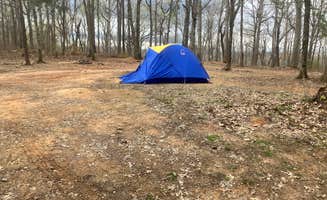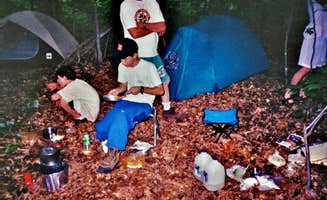Uwharrie National Forest offers primitive camping options approximately 45 miles east of Indian Trail, North Carolina. Most dispersed sites sit at elevations between 500-1,000 feet with mixed hardwood and pine forest coverage. Free camping near Indian Trail, North Carolina requires preparedness as seasonal conditions vary dramatically from sweltering humid summers to occasionally icy winter conditions.
What to do
Off-road adventures: The OHV trail system in Uwharrie National Forest attracts many visitors seeking rugged terrain challenges. "We also took our Jeep on the OHV trails and had a blast. There are several places you can take a canoe or kayak on and the scenery on the lake was beautiful as well," notes Erica from Uwharrie National Forest.
Kayaking: Access the Little River via established boat ramps for water-based camping exploration. Visitors can paddle to remote sites unreachable by vehicle. This provides a quieter camping experience than roadside locations, with fewer weekend crowds during peak seasons.
Hunting: The forest provides designated hunting areas during season. "This area was a place that I went often to deer hunt in the fall. I have never came across another camper/hunter at this location. It is a good location if you are looking for an area that is away from camp grounds and heavy traffic," shares Wyatt M.
What campers like
Seclusion: Many dispersed sites offer significant privacy compared to established campgrounds. "We stayed in 2 different dispersed primitive sites and they were both great. Plenty of space and trees and privacy!" reports a camper at Uwharrie.
Water accessibility: Multiple dispersed sites feature stream access important for longer stays. "Along the Uwharrie trail. Water available on both sides of camp/trail," notes Wayne R. about Dispersed Camping off Falls Dam Trail.
Range of difficulty: The forest provides camping options varying from easily accessible sites near trailheads to more remote backcountry locations requiring hiking or paddling. This allows visitors to match their experience level with appropriate sites.
What you should know
Vehicle requirements: Many dispersed sites require appropriate vehicles. "This is a great area for dispersed campers with 4WD or AWD. It's pretty popular so head out early to secure your spot," advises Zachary S.
Supply planning: No facilities exist at most primitive sites. "Obviously, there are no facilities, so I had to take my own water and a water filter. Since I was close to a stream, I had to take care of personal business about two hundred feet farther away," explains Myron C.
Trail conditions: Some trails become challenging after weather events. "The trailhead is kind of hard to follow sometimes, sections of the trail are prone to flooding and creek crossings can become difficult following heavy rains," warns Sean R.
Permits: Overnight permits may be required for certain areas, typically available for purchase at local businesses. Regulations change seasonally, so verifying current requirements before arrival prevents compliance issues.
Tips for camping with families
Safety during hunting seasons: Family groups need to consider timing their visits around hunting activity. "Make sure to wear bright colors during hunting season because there are a ton of people out deer hunting in this area," advises Brandon D.
Noise considerations: Some campsites remain within earshot of highways. "I hiked along the creek at what was marked as campsite 1 along the Uwharrie Trail. It was a short hike and easy to moderate. Unfortunately, it wasn't far enough away to hear distant noises from Hwy 24, so if you want to get away from traffic noise completely, hike farther in," suggests Myron C.
Site cleanliness: Teach children leave-no-trace principles while camping. "Some of the sites may have a little trash left from the last user, so please try to leave it cleaner than you came to," recommends Zachary S.
Tips from RVers
Generator use: Some dispersed areas permit generator use for RVs without hookups. "We used our pop-up with a generator in rustic locations," notes Bart about camping options in the forest.
Site selection timing: Arrive early, especially on weekends. Popular dispersed sites fill quickly during peak seasons (spring and fall), with Friday arrivals recommended for securing preferred locations.
Supply limitations: No water or electric hookups exist at dispersed sites, requiring complete self-sufficiency. Campers should arrive with full water tanks and charged batteries as resupply options remain limited within the forest boundaries.



